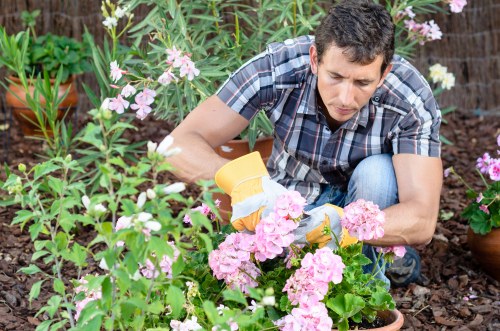Hedge Trimming in Lucy Lucid Gardening

Introduction to Hedge Trimming
Hedge trimming is a crucial aspect of garden maintenance that enhances the aesthetic appeal and health of your plants. At **Lucy Lucid Gardening**, we specialize in providing top-notch hedge trimming services that cater to both residential and commercial properties. Proper trimming ensures that your hedges remain lush, vibrant, and well-structured throughout the year.
Whether you're aiming for a formal look with precisely shaped hedges or a more natural, flowing appearance, our team of experienced gardeners can help you achieve your desired outcome. Understanding the different techniques and tools involved in hedge trimming is essential for maintaining the beauty and longevity of your garden.
In this article, we'll delve into the various aspects of hedge trimming, including the best practices, tools required, and common mistakes to avoid. By the end of this guide, you'll have a comprehensive understanding of how to keep your hedges in pristine condition.

Why Hedge Trimming is Important
Regular hedge trimming offers numerous benefits that extend beyond mere appearance. Here are some key reasons why hedge trimming is essential:
- Promotes Healthy Growth: Trimming removes dead or diseased branches, allowing the plant to focus its energy on healthy growth.
- Prevents Overgrowth: Controlling the size and shape of your hedges prevents them from becoming unruly and invasive.
- Enhances Curb Appeal: Well-maintained hedges contribute significantly to the overall look of your garden or property.
- Increases Sunlight Penetration: Trimming dense hedges allows more sunlight to reach the lower branches and surrounding plants.
At Lucy Lucid Gardening, we emphasize the importance of timely and proper trimming to ensure that your hedges remain healthy and attractive.
Neglecting hedge maintenance can lead to several issues, such as pest infestations, diseases, and structural weaknesses. By staying on top of your hedge trimming schedule, you can prevent these problems from taking hold.

Types of Hedges and Trimming Techniques
Formal Hedges
Formal hedges are characterized by their precise and symmetrical shapes. They are often used to create clear boundaries and add structure to a garden. Common examples include boxwood and yew hedges.
Key Features:
- Defined edges and uniform shape
- Regular maintenance is required
- Best suited for structured garden designs
Informal Hedges
Informal hedges have a more natural, flowing appearance. They are typically less rigid in shape and can incorporate a variety of plant species.
Key Features:
- Organic shapes and forms
- Allow for more biodiversity
- Require less frequent trimming
Trimming Techniques
Different types of hedges require specific trimming techniques to maintain their shape and health. Here are some common methods:
- Shearing: Using hedge trimmers to create straight lines and uniform shapes, ideal for formal hedges.
- Selective Pruning: Removing specific branches to improve airflow and sunlight penetration, suitable for both formal and informal hedges.
- Rejuvenation Pruning: Cutting back old, overgrown hedges to stimulate new growth.

Tools and Equipment for Hedge Trimming
Essential Tools
Having the right tools is essential for effective and safe hedge trimming. Here are the must-have tools for the job:
- Hedge Trimmers: Available in manual, electric, and gas-powered varieties, these are essential for cutting through thick hedges.
- Pruning Shears: Ideal for trimming smaller branches and achieving detailed cuts.
- Loppers: Useful for cutting larger branches that are too thick for pruning shears.
- Safety Gear: Gloves, safety glasses, and protective clothing to ensure your safety while trimming.
Maintenance of Tools
Proper maintenance of your trimming tools ensures their longevity and effectiveness. Regularly clean your tools after use, sharpen blades as needed, and store them in a dry place to prevent rust and damage.
Tips for Maintaining Your Tools:
- Clean blades after each use to remove sap and debris.
- Sharpen blades regularly to maintain cutting efficiency.
- Lubricate moving parts to ensure smooth operation.

Best Practices for Hedge Trimming
Timing Your Trims
The timing of hedge trimming can significantly impact the health and appearance of your plants. Generally, the best times to trim hedges are:
- Late Spring: After the initial growth spurt, allowing the plant to set new buds.
- Early Autumn: Before the onset of colder weather, promoting strong growth in the spring.
Avoid trimming hedges during extreme weather conditions, such as late summer droughts or severe winter cold, as this can stress the plants.
Proper Cutting Techniques
Using the correct cutting techniques ensures that your hedges heal properly and maintain their desired shape. Here are some tips:
- Cut at an Angle: This promotes better water runoff and reduces the risk of disease.
- Avoid Cutting Too Low: Leave enough foliage to sustain the plant's health.
- Make Clean Cuts: Use sharp tools to make precise cuts that minimize damage to the plant.
Shaping Your Hedges:
- Visualize the desired shape before trimming.
- Start by trimming the sides before addressing the top.
- Step back frequently to assess the symmetry and balance of your hedges.

Common Mistakes to Avoid
Over-Trimming
One of the most common mistakes in hedge trimming is over-trimming. Cutting back too much foliage can stress the plant, making it more susceptible to diseases and pests.
Signs of Over-Trimming:
- Exposed stems and branches
- Sparse foliage
- Slowed growth
To avoid over-trimming, limit the amount of foliage you remove during each trimming session and follow the recommended trimming schedule.
Ignoring Plant Health
Trimming a hedge without considering the overall health of the plant can lead to long-term issues. Always inspect your hedges for signs of disease or pests before trimming.
Preventative Measures:
- Regularly inspect your hedges for pests and diseases.
- Use appropriate treatments if you detect any issues.
- Maintain good garden hygiene to prevent the spread of diseases.
Using Incorrect Tools
Using the wrong tools for hedge trimming can cause damage to the plants and make the job more difficult. Ensure you have the right tools for the size and type of hedge you are trimming.
Tool Selection Tips:
- Choose hedge trimmers with blades suitable for the thickness of your hedges.
- Use pruning shears for detailed work and loppers for larger branches.
- Invest in high-quality tools to ensure efficiency and longevity.
Poor Timing
Trimming your hedges at the wrong time can hinder their growth and health. Follow the recommended trimming schedule to ensure timely maintenance.
Timing Best Practices:
- Trim in late spring and early autumn.
- Avoid trimming during extreme weather conditions.
- Schedule regular trims to maintain consistent growth.

Environmental Considerations
Sustainable Trimming Practices
At Lucy Lucid Gardening, we are committed to environmentally friendly gardening practices. Sustainable hedge trimming minimizes the impact on the ecosystem while maintaining the beauty of your garden.
Eco-Friendly Tips:
- Use manual or electric tools to reduce carbon emissions.
- Compost trimmed branches and leaves instead of disposing of them.
- Choose native plant species that require less water and maintenance.
Impact on Local Wildlife
Hedges provide essential habitats for various wildlife species. Trimming should be done thoughtfully to preserve these habitats and support biodiversity.
Wildlife-Friendly Practices:
- Leave some untrimmed areas to provide shelter for birds and insects.
- Avoid using chemical fertilizers or pesticides that can harm wildlife.
- Trim hedges during times when wildlife activity is low to minimize disturbances.
Water Conservation
Proper hedge trimming can also contribute to water conservation efforts. Overgrown hedges can create microclimates that either lead to excessive water usage or insufficient drainage.
Water-Smart Trimming:
- Maintain open structures in your hedges to improve air circulation and reduce moisture build-up.
- Ensure proper drainage by trimming back dense growth that can block water flow.
- Choose drought-resistant plant species for your hedges.

Seasonal Hedge Trimming Tips
Spring Trimming
Spring is an ideal time to trim hedges as it allows the plants to recover quickly and promote new growth. Here's how to approach spring trimming:
- Remove any winter damage and dead branches.
- Shape the hedges by trimming to the desired form.
- Apply a balanced fertilizer to support new growth.
Summer Trimming
During the summer months, occasional light trimming can help maintain the shape and encourage dense foliage.
Summer Maintenance Tips:
- Pinch back new growth to promote bushiness.
- Water regularly to support healthy growth.
- Monitor for pests and treat as necessary.
Autumn Trimming
Autumn trimming prepares your hedges for the upcoming winter, ensuring they remain healthy and resilient.
- Cut back any overly long or unruly branches.
- Clear away any debris to prevent disease.
- Apply mulch around the base to protect the roots from cold temperatures.
Winter Trimming
Winter is generally not the best time for heavy hedge trimming. However, light maintenance can be done if necessary.
Winter Care Tips:
- Trim any branches damaged by winter storms.
- Avoid heavy trimming to prevent stress on the plants.
- Plan for major trimming in the spring when growth resumes.

Hiring Professional Hedge Trimming Services
Benefits of Professional Services
While DIY hedge trimming is possible, hiring professionals like those at Lucy Lucid Gardening offers several advantages:
- Expertise: Professionals have the knowledge and experience to trim hedges effectively and safely.
- Time-Saving: Outsourcing the task frees up your time for other activities.
- Proper Equipment: Professionals have access to the right tools and equipment for the job.
- Consistent Results: Professional trimming ensures a uniform and polished appearance.
Choosing the Right Service Provider
When selecting a hedge trimming service, consider the following factors:
- Experience: Look for companies with a proven track record in hedge trimming.
- Reputation: Check reviews and testimonials to gauge customer satisfaction.
- Services Offered: Ensure the provider offers the specific services you need.
- Pricing: Compare quotes to find a service that fits your budget.
At Lucy Lucid Gardening, we pride ourselves on delivering exceptional hedge trimming services tailored to your specific needs.
Questions to Ask Potential Providers:
- What is your experience with hedge trimming?
- Can you provide references or testimonials?
- What tools and techniques do you use?
- How do you handle cleanup after trimming?
Cost Considerations
The cost of professional hedge trimming varies based on factors such as the size of the hedges, the complexity of the trim, and the location. It's essential to obtain detailed quotes and understand what is included in the service.
- Get multiple quotes to compare pricing.
- Understand the pricing structure (per hour, per linear foot, etc.).
- Ask about any additional fees for specialized services.
Scheduling and Frequency
Establishing a regular trimming schedule ensures that your hedges remain in optimal condition. Discuss with your service provider the best frequency for your specific types of hedges and your garden's requirements.
Ideal Trimming Frequencies:
- Formal hedges: Every 6-8 weeks during the growing season.
- Informal hedges: Every 12-16 weeks, depending on growth rate.
- Rejuvenation trimming: Once every few years, as needed.
Preparing for the Service
To ensure a smooth and efficient hedge trimming service, prepare your garden beforehand:
- Clear the area around the hedges from any obstacles.
- Remove delicate plants that might be affected by trimming.
- Discuss any specific requirements or preferences with your service provider.
Post-Trimming Care:
- Inspect the trimmed hedges for any signs of damage.
- Apply mulch or fertilizer if recommended by the professionals.
- Maintain a regular watering schedule to support recovery and new growth.

DIY Hedge Trimming Tips
Planning Your Trim
If you prefer to trim your hedges yourself, proper planning is key to achieving the best results. Here's how to get started:
- Assess the Hedges: Determine the type and condition of your hedges to decide on the appropriate trimming approach.
- Gather Tools: Ensure you have all the necessary tools, including hedge trimmers, pruning shears, and safety gear.
- Set a Schedule: Plan your trimming sessions during optimal times of the year.
Step-by-Step Trimming Guide
- Start with Clean Tools: Sanitize your tools to prevent the spread of diseases.
- Trim the Sides First: Begin by cutting the sides of the hedge to your desired width.
- Shape the Top: Proceed to trim the top, maintaining an even height.
- Check for Symmetry: Step back frequently to ensure both sides are balanced and symmetrical.
- Final Touches: Use pruning shears for any detailed adjustments.
Safety Precautions
Trimming hedges can be hazardous if proper safety measures are not followed. Here are some essential safety tips:
- Wear protective gloves and safety glasses to protect against debris.
- Ensure your ladder is stable if trimming tall hedges.
- Be cautious of power lines and other obstacles.
- Take regular breaks to prevent fatigue and maintain focus.
Handling Common Challenges
Even with careful planning, you may encounter challenges during hedge trimming. Here’s how to handle some common issues:
Thick or Overgrown Hedges:
- Start by trimming smaller sections to make the task manageable.
- Use loppers or saws for thicker branches.
- Gradually work towards your desired shape to avoid overwhelming the plant.
Uneven Growth:
- Identify and focus on areas with sparse growth.
- Trim more heavily in these sections to encourage denser foliage.
- Consider fertilizing to support healthy growth.
Pest Infestation:
- Inspect your hedges regularly for signs of pests.
- Use natural or chemical treatments as needed.
- Remove and dispose of any heavily infested branches.

Post-Trimming Maintenance
Inspecting the Hedges
After trimming, it's important to inspect your hedges to ensure they are healthy and free from any damage or disease. Look for:
- Signs of stress or damage
- New growth patterns
- Presence of pests or diseases
Watering and Feeding
Proper watering and feeding are essential for the recovery and growth of your trimmed hedges. Follow these guidelines:
- Watering: Ensure your hedges receive adequate water, especially during dry periods.
- Feeding: Apply a balanced fertilizer to provide necessary nutrients for new growth.
Top Dressing:
- Apply a layer of compost or mulch around the base of the hedges.
- This helps retain moisture and suppress weeds.
- Avoid piling mulch directly against the stems to prevent rot.
Monitoring Growth
Keep an eye on your hedges as they regrow to ensure they remain healthy and well-shaped. Regular monitoring allows you to address any issues promptly.
- Check for uniform growth and symmetry.
- Trim any new unwanted branches as they appear.
- Adjust your trimming schedule based on the growth rate.
Long-Term Care Tips
Maintaining well-trimmed hedges is an ongoing process that requires consistent care. Here are some long-term tips:
- Regular Trimming: Stick to your trimming schedule to prevent overgrowth.
- Proper Nutrition: Ensure your hedges receive the necessary nutrients through regular feeding.
- Pest Management: Stay vigilant against pests and diseases to maintain hedge health.
- Seasonal Adjustments: Adapt your care routine based on seasonal changes and weather conditions.
Adapting to Climate:
- Choose hedge plants that are well-suited to your local climate.
- Adjust watering and feeding practices based on weather patterns.
- Provide additional protection during extreme weather events.
Enhancing Hedge Health
Healthy hedges are easier to maintain and more visually appealing. Focus on the following to enhance hedge health:
- Ensure adequate sunlight exposure by proper trimming.
- Maintain good soil health through regular amendments and composting.
- Prune regularly to encourage airflow and reduce the risk of fungal diseases.
Integrating with Overall Garden Design
Your hedges should complement the overall design of your garden. Consider the following:
- Choose hedge shapes that align with your garden theme.
- Use hedges to create zones and define spaces within your garden.
- Incorporate flowering plants or evergreens for added interest and texture.

Conclusion
Hedge trimming is a vital component of garden maintenance that significantly impacts the beauty and health of your outdoor space. With the expertise and services provided by **Lucy Lucid Gardening**, you can ensure your hedges are always in top condition, enhancing the overall appeal of your property.
By following the best practices, using the right tools, and maintaining a regular trimming schedule, you can achieve and maintain perfectly shaped hedges that contribute to a stunning and well-organized garden. Whether you choose to undertake hedge trimming yourself or hire professionals, understanding the key aspects of the process is essential for success.
Take the Next Step
Ready to transform your garden with expertly trimmed hedges? **Contact us today** to schedule your hedge trimming service with Lucy Lucid Gardening. Let our team of professionals help you achieve the garden of your dreams.
Don't wait—**book your service now** and experience the difference that professional hedge trimming can make!



